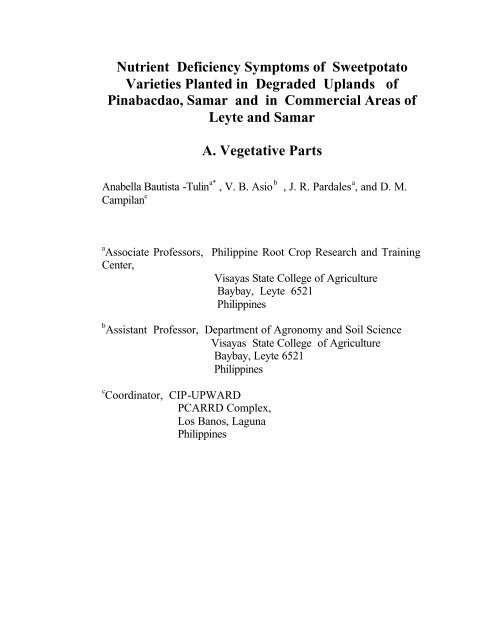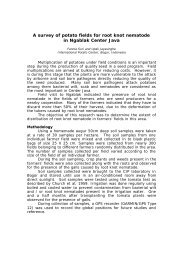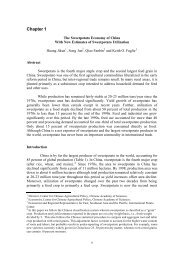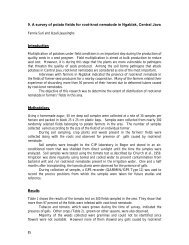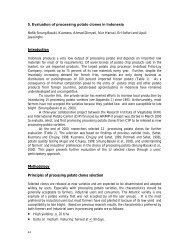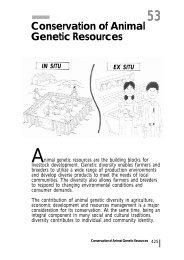Nutrient Deficiency Symptoms of Sweetpotato Varieties ... - cip-eseap
Nutrient Deficiency Symptoms of Sweetpotato Varieties ... - cip-eseap
Nutrient Deficiency Symptoms of Sweetpotato Varieties ... - cip-eseap
- No tags were found...
Create successful ePaper yourself
Turn your PDF publications into a flip-book with our unique Google optimized e-Paper software.
<strong>Nutrient</strong> <strong>Deficiency</strong> <strong>Symptoms</strong> <strong>of</strong> <strong>Sweetpotato</strong><strong>Varieties</strong> Planted in Degraded Uplands <strong>of</strong>Pinabacdao, Samar and in Commercial Areas <strong>of</strong>Leyte and SamarA. Vegetative PartsAnabella Bautista -Tulin a* , V. B. Asio b , J. R. Pardales a , and D. M.Campilan ca Associate Pr<strong>of</strong>essors, Philippine Root Crop Research and TrainingCenter,Visayas State College <strong>of</strong> AgricultureBaybay, Leyte 6521Philippinesb Assistant Pr<strong>of</strong>essor, Department <strong>of</strong> Agronomy and Soil ScienceVisayas State College <strong>of</strong> AgricultureBaybay, Leyte 6521Philippinesc Coordinator, CIP-UPWARDPCARRD Complex,Los Banos, LagunaPhilippines
ABSTRACTA study was conducted on the assessment <strong>of</strong> nutritional disorders in foursweetpotato varieties representing two traditional (Kaangi and Kasapad) varietiesgrown in the degraded upland and two improved or recommended varieties (PSBSP 17 and PSB SP 19) varieties grown in commercial areas using the solutionculture technique. <strong>Nutrient</strong> deficiency symptoms were established for thefollowing elements: without nitrogen (-N), without phosphorus (-P), withoutpotassium (-K), without magnesium (-Mg), without calcium (-Ca), withoutsulfur (-S), without Fe (-Fe), and without micronutrients (-Micro). For thecontrol , we used sweetpotato receiving complete nutrient elements (Completetreatment). Thirty six healthy stem cuttings <strong>of</strong> each <strong>of</strong> the four sweetpotatovarieties were used in the study and these were allowed to root for one weekbefore placing them in culture bottles containing the culture solutionsrepresenting the various treatments. <strong>Sweetpotato</strong> were grown in the culturebottles/containers for more than two months and visible deficiency symptoms <strong>of</strong>each element were noted as they occur in the leaves, shoots and roots <strong>of</strong> theplants.Results showed that each nutrient element has characteristic deficiencysymptoms although there are some similarities in the general performance <strong>of</strong>sweetpotato in nutrient deficient culture solutions. These similarities include thestunted growth <strong>of</strong> the plant, general yellowing <strong>of</strong> leaves and sometimes in theoccurrence <strong>of</strong> chlorosis. In some instances, different varieties also showed varyingresponses to these nutritional disorders.Keywords: sweetpotato varieties, nutrient elements, nutritional disorders,deficiency symptoms__________________________________________________________________2
their timely diagnosis is important for the crop to recover once the disorder iscorrected.These metabolic disturbances to growth and development <strong>of</strong> plants results notonly in tremendous yield losses and reduction <strong>of</strong> quality , but they also result infinancial losses particularly in modern agriculture with intensive crop production.Farmers, growers and foresters cannot afford unfavorable nutritional conditionswhich lead to nutrient imbalances in the plants considering their limitedresources. Thus early diagnosis <strong>of</strong> nutrient disorders in plant is important toprevent the above losses.Visual and analytical diagnosis during growth and development provide twocomplimentary methods for identifying nutritional disorders <strong>of</strong> plants whichpermit them to be distinguished from pathological damages (Bergmann, 1992).One advantage <strong>of</strong> the production <strong>of</strong> specific visible symptoms is that it is notdependent on costly laboratory equipment or time-consuming chemical analyses(O’Sullivan, et al., 1995). It should be noted also that in addition to theappearance <strong>of</strong> a particular symptom, the position <strong>of</strong> that symptom on the plantmust be properly indicated. It is because nutrients are being absorbed by the rootsystem and distributed among various plant parts.This study was conducted to determine the various nutrient disorders insweetpotato through visual diagnosis <strong>of</strong> deficiency symptoms using twotraditional sweetpotato cultivars (Kaangi and Kasapad) grown in degraded uplandareas <strong>of</strong> Pinacbacdao, Samar and two recommended sweetpotato varieties (PSBSP 17 and 19) grown in commercial areas <strong>of</strong> Leyte, Samar and Tarlac provinces.<strong>Nutrient</strong> deficiency symptoms were categorized into 2 namely: a.) using thesweetpotato vegetative plants parts consisting <strong>of</strong> the leaves and shoots; and b)using sweetpotato roots. These deficiency symptoms were established using thesolution culture technique. This paper will report the deficiency symptomsexhibited by the leaves and and shoots. The nutritional disorders affecting thesweetpotato roots will be reported in succeeding paper.A. Preparation <strong>of</strong> plant samplesMATERIALS AND METHODSTwenty cm <strong>of</strong> sweetpotato cuttings representing the two indigenouscultivars Kaangi and Kasapad and the two new sweetpotato varieties PSB SP 17and 19) were taken from healthy plants grown at PRCRTC Germplasm area.These were allowed to root for four days in the laboratory using distilled water asa rooting medium. After four days, these cuttings were transferred in ambercolored bottles containing different concentrations <strong>of</strong> essential elements insolution cultures and allowed to grow for a period <strong>of</strong> more than two months which4
is the critical growth stage <strong>of</strong> sweet potato plant as shown in the growth curve <strong>of</strong>a typical sweetpotato plant as represented by sweetpotato VSP-2 variety(Bautista , 1990).B. Preparation <strong>of</strong> culture containersBeer bottles and 600 ml beakers were used as culture containers. The beerbottles were used during initial stage <strong>of</strong> the experiment up to 2 weeks period. Thebeakers were used right after the beer bottles when the plants have developedpr<strong>of</strong>use rooting systems which could no longer be accommodated by the mouth <strong>of</strong>the beer bottles. Both containers were cleaned thoroughly and washed with NHCl to remove any contaminants. Then these were covered with black carbonpaper to prevent the oxidation <strong>of</strong> culture solutions inside the bottles. Nine beerbottles and beakers were labeled as follows: complete, -N, -P, -K, -Ca, -Mg, -S, -Fe, and -Micro. The treatments were replicated three times. In the beerbottles, the sweetpotato cuttings were wrapped with a small piece <strong>of</strong> cotton as asupport to prevent them from falling over. While in the beaker, the sweetpotatocuttings were suspended on a screen wire and placed on top <strong>of</strong> the beakerscontaining the different culture solutions.C. Compounding the culture solutionsThe culture solutions were prepared following the concentrations <strong>of</strong>Hoagland’s No. 2 culture solution as presented in Table 1.Table 1. The salt composition <strong>of</strong> Hoagland’s No. 2 culture solutionSALTSCONCENTRATION (moles/l)1. KNO 3 0.0062. Ca(NO 3 ) 2 .4H 2 O 0.0043. MgSO 4 .7H 2 O 0.0024. (NH 4 )H 2 PO 4 0.0015. Fe (added as FeCl 3 ) 5 ppm6. Microelementsa. H 3 BO 3 2.86 gm/lb. MnCl 2 .4H 2 O 1.81 gm/lc. ZnSO 4 .5H 2 O 0.22 gm/ld. MoO 3 0.02 gm/le. CuSO 4 .5H 2 O 0.08 gm/l_________________________________________________________________5
The different culture solutions representing the nine treatments (-N, -P, -K,-Ca, -Mg, -S, -Fe, -Micro and Complete were prepared using the various saltspresented in Table 1 as tabulated in Table 2. Two liters <strong>of</strong> each treatment wereinitially prepared and the culture solutions were stored in amber bottles in thelaboratory. After the sweetpotato cuttings had started to develop some roots indistilled water, the experimental set-up was started. For the beer bottles, theculture solutions were poured up to the neck <strong>of</strong> the bottle and one cutting weretransferred into each bottle. The sweetpotato cuttings were wrapped with smallcotton swab to prevent them from falling over. While in the beakers, fourhundred ml <strong>of</strong> culture solutions representing the nine treatments were poured intotheir respective beakers and the sweetpotato cuttings suspended on the screenwires were placed on top <strong>of</strong> the beakers. The plants were then kept in the screenhouse for a period <strong>of</strong> two months. The culture solutions in the both in the beerbottles and the beakers were changed every other day and the plants were alsoaerated two to three times a week.Table 2. Checklist for the different culture solutions.SALTSTREATMENTS-N -P -K -Ca -Mg -S -Fe -Micro CompleteKNO 3 X X X X X X XCa(NO 3 ) 2 .4H 2 O X X X X X X XMgSO 4 .7H 2 O X X X X X X XNH 4 H 2 PO 4 X X X X X X XMicroelements X X X X X X X XFe X X X X X X X XNaNO 3XCaCl 2 .2H 2 OXKClXMgCl 2 .6H 2 OXNa 2 SO 4XNH 4 ClXNaH 2 PO 4 .H 2 O XNaNO 3 * (2 volumes)X• For –Ca treatment only6
D. Care and maintenance <strong>of</strong> the plantsThe plants were put inside the screen house and visual observations forthe appearance <strong>of</strong> deficiency symptoms were noted daily. The culturesolutions were regularly replaced every other day to prevent the growth <strong>of</strong>molds and bacteria which might contaminate the cuttings. The cuttings werealso properly monitored for the occurrence <strong>of</strong> any disease <strong>of</strong> insect damage.The plants were also aerated regularly to ensure that they receive enoughoxygen for its growth and development.RESULTS AND DISCUSSIONI. Characteristics <strong>of</strong> the Four <strong>Sweetpotato</strong> <strong>Varieties</strong> Used:Table 3 presents the characteristics <strong>of</strong> the four sweetpotato varietiesused. The different morphological characteristics described include planttype, leaf lobing, leaf color, root skin color and root flesh color. Onedistinguishing feature <strong>of</strong> these morphological characteristics which isimportant in the study is the leaf color since this will in some ways affectthe visual appearance <strong>of</strong> deficiency symptoms exhibited by the leaves.Table 3 . Varietal characteristics <strong>of</strong> <strong>Sweetpotato</strong> varieties Kaangi,Kasapad, PSB SP 17, and PSB SP 19.Characterisctics Kasapad Kaangi PSB SP 17 PSB SP 19Plant type creeping creeping creeping erectLeaf Color green green yellow/green purpleStem Color green light purple green purpleLeaf Lobing slightly lobed heart shaped slightly lobed slightly lobedRoot Skin Color white purple purple light orangeRoot Flesh Color yellow yellow orange yellow light yellowII. Description <strong>of</strong> <strong>Deficiency</strong> <strong>Symptoms</strong> :1. Nitrogen <strong>Deficiency</strong>General symptoms exhibited by N deficient sweetpotato leavesinclude yellowing <strong>of</strong> leaves and early senescence <strong>of</strong> older or basal leaves(Plate Nos. 1A to 1D) . The leaves <strong>of</strong> N deficient sweetpotato are alsosmaller in sizes as compared to those receiving complete treatments. Theshade <strong>of</strong> yellowing differ in varieties wherein the improved varieties7
produced intense yellow coloration as compared to the traditionalvarieties. Nitrogen deficiency symptoms usually affect both the older andyounger leaves. This is very evident in the plant shoots which showedstunted growth and generally smaller leaf sizes (Plate Nos. 1E to 1H) ascompared to the plants receiving complete nutrient treatments (Plate Nos.E to H ).2. Phosphorus <strong>Deficiency</strong>General symptoms <strong>of</strong> phosphorus deficient sweetpotato leavesinclude marginal chlorosis or interveinal spotting <strong>of</strong> basal leaves, dryingup <strong>of</strong> basal leaves, localized yellowing <strong>of</strong> older leaves with interveinalchlorosis and intense browning or coloration <strong>of</strong> the tips or edges <strong>of</strong> leaves(Plate Nos. 2A to 2D). Differences in varietal response to P deficiencywas evident in the four sweetpotato varieties used wherein the improvedvarieties showed more <strong>of</strong> interveinal chlorosis as compared to thetraditonal varieties which showed more <strong>of</strong> the yellowing and browning <strong>of</strong>tips <strong>of</strong> the leaves. Like nitrogen , sweetpotato receiving no phosphorusshowed stunted growth as shown by their vegetative parts /shoots (PlateNos. 2E to 2H). This simply showed the important role played byphosphorus in the growth and development <strong>of</strong> sweetpotato especially inits involvement in energy transduction (Glass, 1989).3. Potassium <strong>Deficiency</strong>The appearance <strong>of</strong> potassium deficiency symptoms occur mainlyon the older leaves and the general symptoms exhibited by sweetpotatoleaves include brown necrotic lesions or spots which developed within thechlorotic zones <strong>of</strong> the leaves, severe yellow chlorosis in the interveinaland marginal zones and in extreme cases the leaves will turn whitish orcompletely lost its green coloration (Plates Nos. 3A to 3D). In potassiumdeficiency, the necrotic stage is usually preceeded by a light greeninterveinal chlorosis affecting mature to older leaves (O’ Sullivan, et al.,1995). The shoots <strong>of</strong> sweetpotato which is deficient in potassiumgenerally exhibit stunted growth (Plates Nos. 3E to 3H) as compared tothose receiving complete nutrient treatments. This has tremendousimplication on the development <strong>of</strong> sweetpotato roots since potassiumphysiologically affect the root formation <strong>of</strong> sweetpotato. Bautista (1981)reported the effects <strong>of</strong> increasing levels <strong>of</strong> potassium fertilizers onenhancing the root yield <strong>of</strong> sweetpotato.4. Sulfur <strong>Deficiency</strong>Plates Nos. 4A to 4D show the nutrient deficiency symptomsexhibited by the leaves <strong>of</strong> four sweetpotato varieties. Generally some <strong>of</strong>the symptoms include uniform pale green chlorosis throughout the plant,in severe cases, the veins no longer retain the green color, red brownpigmentation developing on older leaves which normally starts at thecenter <strong>of</strong> the leaves, browning <strong>of</strong> leaves and total loss / or reduction <strong>of</strong>8
green pigmentation. In some varieties the leaves appeared wilted andtotally dried up with dark yellowing on the sides. In varieties with purpletips, the color becomes paler, while the older leaves would turn goldenyellow in color. The shoots <strong>of</strong> sulfur deficient sweetpotato also showedsevere stunting and some variety like the PSB SP 19 which normallyhave purplish shoot tips tend to lost its dark purple pigmentation while theolder leaves turned yellowish in color (Plates Nos. 4E and 4H).5. Calcium <strong>Deficiency</strong>The primary symptoms <strong>of</strong> calcium deficiency in sweetpotatoinclude necrosis <strong>of</strong> young expanding leaves which may lead to failure <strong>of</strong>the leaf to develop and finally to the death <strong>of</strong> the apex (Plates Nos. 5A to5D). This is clearly exhibited by the Kasapad variety as shown by its leaf(Plate No. 5B) and shoot (Plate No. 5G) symptoms. In calcium deficiency,the necrosis spread from irregular patches especially along the lateralmargins nearing the petiole and extends inward mainly in the interveinaltissues (O’ Sullivan, et al., 1995). A similar symptoms were observedwith the cultivars from the Pacific. Generally calcium deficient plantfailed to extend its growth stage as shown by its inability to increase theshoot length due to shoot “die back”. All the sweetpotato shoots we usedfailed to increase its length as shown in the pictures (Plates 5E to 5H).This is because the root tips <strong>of</strong> sweetpotato without calcium treatmentbecomes rotten/swollen and failed to grow making it impossible for theabsorption <strong>of</strong> other nutrients to occur.6. Magnesium <strong>Deficiency</strong>The general symptoms <strong>of</strong> magnesium deficiency include interveinalchlorosis <strong>of</strong> the older leaves and the yellowing <strong>of</strong> the younger leaves(Plates Nos. 6A to 6D). As the chlorosis intensifies, the dark green color<strong>of</strong> the leaves changed to yellow green, pale yellow to golden yellow .Leaves <strong>of</strong> other varieties may turn brownish and dry as shown byKasapad variety (Plate Nos. 6B). The shoots are generally very thin withthe younger leaves showing severe chlorosis aside from its stuntedgrowth (Plate Nos. 6E to 6H). The four varieties showed a yellow greento pale yellow color <strong>of</strong> the leaves which are generally lighter in coloras compared to the chlorotic older leaves.7. Iron <strong>Deficiency</strong>One major distinguishing feature <strong>of</strong> iron deficiency in sweetpotatoas shown by our samples is the chlorosis <strong>of</strong> the younger leaves (PlatesNos. 7A to 7H). At the onset <strong>of</strong> interveinal chlorosis, a sharplycontrasting green network <strong>of</strong> veins occur which eventually led thedevelopment <strong>of</strong> white chlorosis and the complete disappearance <strong>of</strong> greencolor on the younger leaves. This symptom is clearly shown by the leavesand shoots/stem <strong>of</strong> Kasapad variety (Plate Nos. 7G). In iron deficiency,the youngest leaves will show the greatest intensity <strong>of</strong> chlorosis. Severely9
affected leaf blades become necrotic (Plate Nos. 7A and 7B), with thenecrosis usually spreading from the tip and margin into interveinal zones.However as the deficiency intensifies, the leaves will be severely necroticand die with its color transforming to dark brown.8. Micronutrient <strong>Deficiency</strong>General symptoms <strong>of</strong> micronutrient deficiency are usuallyexhibited by the growing tissues such as the shoots and roots. The leavessymptoms include interveinal chlorosis with some veins still retaining thegreen color, distortion <strong>of</strong> leaves with the curling <strong>of</strong> the lateral lobes on thesides (Plate Nos. 8A to 8D). Some variety shows localized chlorosis on theedge <strong>of</strong> the lateral lobes as shown by the Kasapad variety(Plate No. 8B).The leaves are generally smaller in sizes and the shoots showed stuntedgrowth. Traditional varieties such as the Kasapad and Kaangi tend to beseverely affected by micronutrient deficiency as compared to theimproved or recommended varieties as shown by their shoot performance(Plate Nos. 8E to 8H). The microelements/micronutrients in thetreatments include sources <strong>of</strong> boron (B), zinc (Zn), manganese (Mn),molybdenum (Mo), and copper (Cu) elements in the solution. The absence<strong>of</strong> the micronutrients in the uptake <strong>of</strong> sweetpotato will exhibit any or acombination <strong>of</strong> the deficiency symptoms <strong>of</strong> the above elements/nutrientswhen they are removed singly in the solution cultures. In this case, thedeficiency symptoms exhibited by the four sweetpotato varieties reflectedmainly the symptoms <strong>of</strong> B, Zn, Mn, Mo, and Cu deficiencies. This isvery evident in the Kasapad variety which showed curling <strong>of</strong> the laterallobes and distortion <strong>of</strong> leaves as an indication <strong>of</strong> boron deficiency (PlateNo. 8B).III.Relationship <strong>of</strong> the Laboratory Assessment <strong>of</strong> Nutritional DisordersWith That <strong>of</strong> Farmers’ Perceptions and Farmers’ IndigenousKnowledge:Before we conduct the assessment <strong>of</strong> crop nutritional disorders in thelaboratory, we interviewed the sweetpotato farmers in Pinabacdao, Samarabout their own perception <strong>of</strong> crop health and how would they assess thisin the field. They gave us their own indicators <strong>of</strong> crop health asenumerated in table 4.10
Table 4. Indicators <strong>of</strong> crop health used by sweetpotato farmer’s inPinabacdao, SamarIndicator Healthy Crop Unhealthy Crop Perceived CauseLeaf Color dark green yellowish lack <strong>of</strong> soil nutrientsLeaf Size large small -do-Growth Rate normal , fast slow, stunted -do-Storage Root Size mostly large mostly small -do-Presence <strong>of</strong> Pest usually more usually less Succulence <strong>of</strong> LeavesMatching the farmers’ indigenous knowledge (IK) on crop healthwith that <strong>of</strong> our own assessment in the laboratory, we could say they havea good perception <strong>of</strong> a healthy and unhealthy crop based on the aboveindicators, although they could not pinpoint which specific nutrient isdeficient or not. They have more or less a general perception <strong>of</strong> theperformance <strong>of</strong> crop based on leaf color and leaf sizes. Our ownlaboratory assessment <strong>of</strong> deficiency symptoms have shown that thegeneral appearance <strong>of</strong> nutrient deficient sweetpotato is the yellowing <strong>of</strong>leaves and the production <strong>of</strong> smaller leaf sizes. This is true for e.g. innitrogen, iron, magnesium deficient sweetpotato. The farmers’ howeverlacked a more detailed assessment <strong>of</strong> specific deficiency symptomswhich are exhibited by certain element like the appearance <strong>of</strong> chlorosis <strong>of</strong>necrosis in the leaves which they might misinterpret as a diseasesymptom. Thus our results in the laboratory will help them validate theirown assessment in the field and this will greatly help them in furthercharacterizing specific nutrient deficiency symptoms as they occur intheir field. This will also give them a better understanding <strong>of</strong> theimportance <strong>of</strong> proper crop nutrition and the contribution to differentnutrient elements on the growth and development <strong>of</strong> sweetpotato. Fromour results they could see that different nutrient elements indeed play amajor role in the development <strong>of</strong> the crop since the absence <strong>of</strong> one majoror even micro element would result to stunted crop growth which willgreatly affect root production and yield <strong>of</strong> sweetpotato.IV.Implications to Integrated <strong>Nutrient</strong> ManagementFrom the results <strong>of</strong> our study we have shown the importance <strong>of</strong> properassessment <strong>of</strong> nutritional disorders in sweetpotato and the vital role played byeach nutrient element in the growth and development <strong>of</strong> the crop. Thus propercrop nutrition should be applied in the field to prevent huge crop losses broughtabout by deficiency <strong>of</strong> one or more nutrient elements. So before we start plantingsweetpotato in the field either in the farmers’ field on in large scale production incommercial areas , proper assessment <strong>of</strong> the fertility/nutritional status <strong>of</strong> the soil11
should be ascertained first. There is also a need for us to apply a wholistic <strong>of</strong>integrated approach to nutrient management in our field to assure that we notonly improve crop/root yield <strong>of</strong> sweetpotato but protect the environment as well.This situation is very important in the degraded uplands wherein the soil isalready depleted <strong>of</strong> some important nutrient elements and also in commercialareas wherein continuous planting <strong>of</strong> sweetpotato will eventually deplete the soil<strong>of</strong> its inherent nutrients .AcknowledgementsWe would like to thank CIP-UPWARD for the financial support <strong>of</strong> this study,and to Mr. Erick Castanas and Ms. Shirleny Gabotero for helping in thelaboratory works and in the report making.REFERENCESBautista, A.T. and R.M. Santiago. 1981. Growth and yield <strong>of</strong> sweet potato asinfluenced by different potassium levels in the three soils types. Annals<strong>of</strong> Tropical Research 3(3): 177-186.Bautista, A.T. 1990. Improvement <strong>of</strong> nitrogen status <strong>of</strong> leaves <strong>of</strong> VSP-2 <strong>Sweetpotato</strong> through foliar fertilization. Unpublished Terminal Report <strong>of</strong>PRCRTC Project no. 168-8710-278. PRCRTC, ViSCA , Baybay, Leyte.65 pp.Bergmann, W. (ed). 1992. Colour atlas nutritional disorders <strong>of</strong> plants: visual andanalytical diagnosis; (English, French, Spanish) . New York:Fischer,.386 pp.Bourke, R. M. 1985. <strong>Sweetpotato</strong> production and research in Papua New Guinea.Papua New Guinea Journal <strong>of</strong> Agriculture, Forestry and Fisheries, 33,89-108.Glass, A.D. M. 1989. Plant Nutrition: An introduction to current concepts.Jones and Bartlett Publishers, Inc. Boston/Portola Valley. 234 pp.O’Sullivan, J.N., C. J. Asher, and F.P.C. Blamey. 1995. Nutritional Disorders <strong>of</strong><strong>Sweetpotato</strong>. ACIAR Working Paper No. 45. Dept. <strong>of</strong> Agr. University<strong>of</strong> Queensland , Brisbane. 75pp.Roa, J.R. 1998. <strong>Sweetpotato</strong> production in Leyte : An overview <strong>of</strong> the1996-97 season. Paper presented at PRCRTC Seminar.Villamayor, F.G. Jr. and V. dR. Amante. 1995. <strong>Sweetpotato</strong> in the UplandAgroecology <strong>of</strong> the Philippines. CIP Publication Series (?)12


